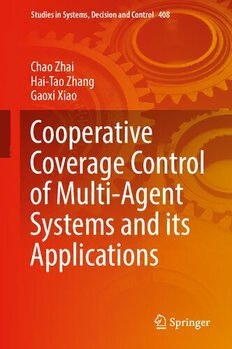Table Of ContentStudies in Systems, Decision and Control 408
Chao Zhai
Hai-Tao Zhang
Gaoxi Xiao
Cooperative
Coverage Control
of Multi-Agent
Systems and its
Applications
Studies in Systems, Decision and Control
Volume 408
SeriesEditor
JanuszKacprzyk,SystemsResearchInstitute,PolishAcademyofSciences,
Warsaw,Poland
The series “Studies in Systems, Decision and Control” (SSDC) covers both new
developments and advances, as well as the state of the art, in the various areas of
broadly perceived systems, decision making and control–quickly, up to date and
withahighquality.Theintentistocoverthetheory,applications,andperspectives
on the state of the art and future developments relevant to systems, decision
making,control,complexprocessesandrelatedareas,asembeddedinthefieldsof
engineering,computerscience,physics,economics,socialandlifesciences,aswell
astheparadigmsandmethodologiesbehindthem.Theseriescontainsmonographs,
textbooks, lecture notes and edited volumes in systems, decision making and
control spanning the areas of Cyber-Physical Systems, Autonomous Systems,
Sensor Networks, Control Systems, Energy Systems, Automotive Systems,
Biological Systems, Vehicular Networking and Connected Vehicles, Aerospace
Systems, Automation, Manufacturing, Smart Grids, Nonlinear Systems, Power
Systems, Robotics, Social Systems, Economic Systems and other. Of particular
valuetoboththecontributorsandthereadershiparetheshortpublicationtimeframe
and the world-wide distribution and exposure which enable both a wide and rapid
disseminationofresearchoutput.
IndexedbySCOPUS,DBLP,WTIFrankfurteG,zbMATH,SCImago.
AllbookspublishedintheseriesaresubmittedforconsiderationinWebofScience.
Moreinformationaboutthisseriesathttps://link.springer.com/bookseries/13304
· ·
Chao Zhai Hai-Tao Zhang Gaoxi Xiao
Cooperative Coverage
Control of Multi-Agent
Systems and its Applications
ChaoZhai Hai-TaoZhang
DepartmentofAutomaticControl SchoolofArtificialIntelligence
SchoolofAutomation andAutomation
ChinaUniversityofGeosciences HuazhongUniversityofScience
Wuhan,China andTechnology
Wuhan,Hubei,China
GaoxiXiao
SchoolofElectricalandElectronic
Engineering
NanyangTechnologicalUniversity
Singapore,Singapore
ISSN2198-4182 ISSN2198-4190 (electronic)
StudiesinSystems,DecisionandControl
ISBN978-981-16-7624-6 ISBN978-981-16-7625-3 (eBook)
https://doi.org/10.1007/978-981-16-7625-3
©TheEditor(s)(ifapplicable)andTheAuthor(s),underexclusivelicensetoSpringerNature
SingaporePteLtd.2021
Thisworkissubjecttocopyright.AllrightsaresolelyandexclusivelylicensedbythePublisher,whether
thewholeorpartofthematerialisconcerned,specificallytherightsoftranslation,reprinting,reuse
ofillustrations,recitation,broadcasting,reproductiononmicrofilmsorinanyotherphysicalway,and
transmissionorinformationstorageandretrieval,electronicadaptation,computersoftware,orbysimilar
ordissimilarmethodologynowknownorhereafterdeveloped.
Theuseofgeneraldescriptivenames,registerednames,trademarks,servicemarks,etc.inthispublication
doesnotimply,evenintheabsenceofaspecificstatement,thatsuchnamesareexemptfromtherelevant
protectivelawsandregulationsandthereforefreeforgeneraluse.
Thepublisher,theauthorsandtheeditorsaresafetoassumethattheadviceandinformationinthisbook
arebelievedtobetrueandaccurateatthedateofpublication.Neitherthepublishernortheauthorsor
theeditorsgiveawarranty,expressedorimplied,withrespecttothematerialcontainedhereinorforany
errorsoromissionsthatmayhavebeenmade.Thepublisherremainsneutralwithregardtojurisdictional
claimsinpublishedmapsandinstitutionalaffiliations.
ThisSpringerimprintispublishedbytheregisteredcompanySpringerNatureSingaporePteLtd.
The registered company address is: 152 Beach Road, #21-01/04 Gateway East, Singapore 189721,
Singapore
Thisbookiswholeheartedlydedicatedtomy
respectablesupervisorsduringmygraduate
andpostdoctoralstudies,aswellasour
groupmembers,withwhomwehaveworked
overtheyearsandhavemadeitpossibleto
reachthismoment.
Tomybelovedfamilies.
Preface
The rapid development of semiconductor and communication technology enables
ustoreadilydeploy,coordinateandcontrolalargenumberofintelligentsensorsor
robotsinavarietyofapplications.Comparedtoasingleagentwithlimitedsensing
and actuating capabilities, a multi-agent system (MAS) is composed of plenty of
intelligentagents(e.g.,smartsensors,robotsandunmannedsystems)thatcommu-
nicate with others and team up to fulfill complicated collective missions, such as
space exploration, formation control, border patrolling, target interception, region
coverage,environmentmonitoring,smuggleseizing,waterpollutionclearance,mate-
rialdeliveryandsoon.Byswarmingintelligenceemergedbyindividualagentsand
inter-agentinteractions,cooperativecontrolcaneffectivelyenhancetherobustness,
adaptabilityandself-organizingcapabilitiesofMASwithlowcostsandhighrelia-
bility.Ontheotherhand,coveragecontrolofMAShasbeenwidelyinvestigatedin
thepastdecadesduetoitsindispensableroleinwirelesssensornetworks,multi-robot
systemsandmultipleunmannedsystems.Essentially,itcentersonhowtomaximize
themonitoringregionbysensorsorenlargingthecoveragerateofagiventerrainto
guaranteenoareaundetectedintheregionofinterests.Nevertheless,theuncertainties
ofexternalenvironmentshavemadeitagreatchallengeforresearcherstodevelop
aneffectivecooperativecontrolapproachtofulfillthecoveragetasksingiventime
periods,whilemaintainingadesiredlevelofcoveragequality.
Todealwiththeaboveissues,thismonographproposesnoveltheoreticalformula-
tionsandpracticalmethodologiesforcooperativecoveragecontrolofMASthrough
thedivide-and-conquerscheme.Onthewhole,thismonographcanbedividedinto
fourparts.
Thefirstpartofthismonographpresentstheresearchbackgroundaswellasthe
stateofartliteraturereviewoncooperativecoveragecontrolapproachesofMAS.In
termsofmulti-robotcoordination,thecooperativecontrolofMAScanbeclassified
as sweep coverage, blanket coverage and barrier coverage. According to the final
state of agents during the coverage, it can be categorized into static and dynamic
coverages.
The second part focuses on the theoretical formulation and technical analysis
of cooperative coverage control approaches of MAS. First of all, we develop a
vii
viii Preface
distributed workload partition algorithm of MAS in order to divide the coverage
regionintomultiplesub-regionswithnearlyequalworkload.Inparticular,theparti-
tion error of workload on sub-regions is estimated via the theory of input-to-state
stability. Then, a decentralized sweep coverage algorithm of MAS is proposed to
completetheworkloadonagivenuncertainregionbyapportioningequalworkload
toaseriesofsub-stripes.Asaresult,eachagentonlyneedstosweepitsownsub-
stripesandmeanwhilepartitionthefuturestripeinacooperativeway.Moreover,we
investigatehowtocoordinatethreeoperationsofsweeping,workloadpartitionand
communicationamongagentsinordertoenhancethecoverageefficiency.Finally,
a fully distributed coverage algorithm of MAS is designed with the assistance of
workloadmemory,andtheinput-to-statestabilityisguaranteedaswell.
Thethirdpartprovidesthepracticalapplicationsofcooperativecoveragecontrol
of MAS in the various fields (e.g., missile interception, intelligent traffic systems
and environment monitoring). In the first case of application, a coverage-based
interception approach is designed to enhance the joint probability of interception
by integrating the cooperative guidance algorithm and the optimal control law for
multipleinterceptorsoflowmaneuverability.Thesecondcasepresentsacoverage-
basedcooperative routingalgorithmsforunmanned systemstoalleviatethetraffic
congestion in the intelligent transportation system. The third application is illus-
tratedinthefieldofenvironmentmonitoringofwirelesssensornetworks,wherea
distributedcoverageapproachisproposedtomaximizethedetectionprobabilityof
geohazards (e.g., landslides, debris flow and surface collapse) and forest fire for a
betterpre-warningmechanism.
Thelastpartsummarizesthemaincontributionsinthismonograph,andoutlines
somepotentialresearchdirectionsforfuturework.
Wuhan,China ChaoZhai
Wuhan,China Hai-TaoZhang
Singapore,Singapore GaoxiXiao
July2021
Acknowledgements
Therehavebeenmanypeoplewhohavewalkedalongsidemeduringmyacademic
journey.Theyhaveguided,supported,andaccompaniedme.Iwouldliketo,hereby,
thankeachofthemsincerely.
Firstandforemost,Iwouldliketoexpressmydeepestgratitudetomyrespectable
supervisorsProf.YiguangHongatInstituteofSystemsScience,ChineseAcademy
ofScience,Beijing,China,andProf.Hai-TaoZhangatSchoolofArtificialIntelli-
gence and Automation, Huazhong University of Science and Technology, Wuhan,
Chinafortheirunwaveringsupport,encouragementandconstructiveguidance.They,
uponwhoseshouldersIstand,exploredandpavedthepathbeforeme.Withouttheir
inspiringguidance,thismonographwouldsimplynothavebeenpossible.Besides,
I would like to thank my postdoctoral supervisor Prof. Gaoxi Xiao at Nanyang
TechnologicalUniversity,Singapore.ProfessorXiaoisalwayswillingtotaketime
to listen and usually provide insightful questions and suggestions, as well as clear
instructionsasfeedback.Hisunstintingsupportandencouragementhavedrivenme
tostriveforexcellence.ManythanksarealsogiventoProf.MarioDiBernardoand
Dr.TimeBarkeratUniversityofBristol,Bristol,UnitedKingdom,Prof.FenghuaHe
atHarbinInstituteofTechnology,Harbin,China,andProf.MichaelZ.Q.Chenat
NanjingUniversityofScienceandTechnology,Nanjing,Chinaforinsightfuldiscus-
sionsontheroutingalgorithminintelligenttransportationsystems,thecooperative
interceptionagainstsupersonicflightvehiclesanddistributedcoveragecontrolusing
workloadmemory.
Secondly,specialthanksaregiventomanyofmyfriendsandcolleaguesincluding
Dr.GuodongShi,Dr.XiaoliWang,Dr.ShijianChen,Dr.YouchengLou,Dr.Yutao
Tang,Dr.XiangruXu,Dr.JiangboZhang,Dr.WenjunSong,Dr.YanqiongZhang,Dr.
PengYi,Dr.ZhenhuaDengandDr.YinghuiWangatInstituteofSystemsScience,
ChineseAcademyofScience,Dr.BingAiatHuazhongUniversityofScienceand
Technology for sharing a wonderful and memorable life with me. In addition, my
wholehearted thanks are given to Dr. Hehong Zhang, Dr. Wenqi Du, Dr. Chaolie
Ning,Dr.YuankunLiu,Dr.BeibeiLiandDr.MinMengatNanyangTechnological
Universityfortheirgeneroussupportandunderstandinggiveninmanymomentsof
ix
x Acknowledgements
crisisovertheyearsinSingapore.Icannotlistallthenameshere,butyouguyshold
aspecialplaceinmyheart.
Finally,andmostimportantly,mymostheartfeltandforevergratitudegoestomy
parentsMr.ShengliZhaiandMrs.XiaohuiZhouandotherfamilymembersincluding
Mrs.JuanjuanZhai,Mr.TaoGuoandMrs.JingjingZhai,whohavealwaysbeena
constantsourceofsupportandencouragement.Thankstomyparentsforputtingme
throughthebesteducationpossibleandgivingmethestrengthtoreachforthestars
and chase my academic dream. I appreciate their sacrifices and unending support,
andIwouldnothavebeenabletogettothisstagewithoutthem.
ThisworkissupportedbytheFundamentalResearchFundsfortheCentralUniver-
sities, China University of Geosciences (Wuhan) and is supported in part by the
National Natural Science Foundation of China under Grant U1713203, in part by
theNaturalScienceFoundation ofHubeiProvinceunderGrant2019CFA005. and
theProgramforCoreTechnologyTacklingKeyProblemsofDongguanCityunder
Grant2019622101007.ItisalsopartiallysupportedbytheFutureResilientSystem
Project(StagesIandII)attheSingapore-ETHCentre(SEC),whichisfundedbythe
NationalResearchFoundationofSingapore(NRF)underitsCampusforResearch
Excellence and Technological Enterprise (CREATE) program, and also supported
byMinistryofEducationofSingaporeunderContractMOE2016-T2-1-119.

